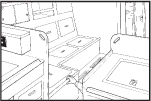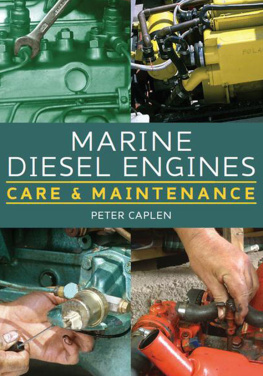THE INTERNATIONAL MARINE SAILBOAT LIBRARY
INSPECTING THE AGING SAILBOAT
DON CASEY

CONTENTS






INTRODUCTION
There are a few well-cared-for yachts into their second century of service, but most boats built 100 years ago, or even 50 years ago, are long gonea pile of gray ash in the bottom of a boatyard stove or a punky skeleton buried in the mud of some creek or canal. Neglect is fatal to wooden boats.
In noticeable contrast, almost every sailboat larger than a skiff and built in the last 35 years, unless lost to violent weather or navigational mishap, is still around. Most see regular service. Even those sitting dirt-covered along the back fence of a boatyard are rarely beyond redemption. The reason for this new immortality is a change in the construction material.
In the late 1940s a handful of boat manufacturers abandoned the practice of constructing hulls from wood in favor of molding hulls from a war-developed synthetic polymer, reinforcing this plastic with glass fibers. Within a dozen years, virtually all production boats were being constructed of glass-reinforced plastic. Because the word plastic had become synonymous in 1950s America with cheap and inferior, boat manufacturers sought to avoid this taint by calling their new construction material fiberglass.
Plastic boats were cheaper, mostly because simplified construction techniques allowed for mass production. This made boat ownership affordable for millions who were previously excluded. As for being inferior, the ability of plastic boats to tolerate slipshod maintenance soon became legendary. Whether the addition of millions of undistinguished and poorly maintained boats to the shorelines and waterways represented a social good is certainly debatable, but for the individual, cheaper and more durable boats were surely better.
Fiberglass boats arent completely impervious to neglect, and they can be damaged. Moreover, a boat is more than simply a hull; many of the assembled components offer less durability. Wood used to reinforce and stiffen is subject to rot. Metal parts corrode or fatigue. Fabrics tear and mildew. Machinery wears out. While these conditions are rarely fatala fiberglass boat in almost any condition can be restoredthe issue is value. Is making needed repairs economically sound? The answer to this question will vary according to who is considering it. A boat that should be avoided by an owner who leaves all repairs to the yard could be a bargain for the skilled do-it-yourselfer.
SURVEYING A BOAT FOR PURCHASE
There arent many experiences more ripe with promise than buying a boat. When you find the very craft you have been dreaming about sulking impatiently on a cradle or shifting restlessly in a slip, perfect days on the water suddenly play through your mind. You step aboard and run your fingers over her in a lovers caress. Look how perfect she is. This is the one! You stand at the helm, gripping the wheel, feeling the wind through your hair, the sun on your back, the motion of
SNAP OUT OF IT!
Are those cracks in the gelcoat? Should the deck crackle like that? Are those rivets in the rubrail, and why are they loose? Why doesnt the head door close? Why are there brown streaks beneath the portlights? Are those water marks inside the galley cabinets? Should there be rust on the keel bolts? What is that bulge in the hull?
If any of these indicate real trouble (and some of them do), it is about to become your trouble. It is going to be your money paying for the repair or, God forbid, your feet treading water. So be still your beating heart; shopping for a boat is about looking for the warts.
But where do you look? And what do you look for? And when you find something, how do you know what it means? Thats what this book is all about.
Wait a minute. Isnt finding a boats problems the job of the surveyor, a real surveyor? Absolutely. If your dream boat is going to cost a substantial (by your definition) amount, a professional survey is essential. A seller is far more likely to make financial concessions based on the findings of a formal survey than on your whining about the very same things. If you plan to finance or insure the boat, a survey will be required anyway. And an experienced surveyor brings a depth of knowledge that is likely to result in findings you might overlook. So why would you want to bother with any of this if youre going to hire a pro?
Consider this. The cost to have a boat professionally surveyed runs about $10 to $15 per foot, plus travel and expenses. Haulout costs can add $3 or $4 per foot, and if you want an engine evaluated, tack on another $300 or more. You want to invest this much money only once in a boat you dont yet own, meaning that before you commission a survey, you want to be 99 percent certain that it isnt going to reveal any defects serious enough to send you looking for a different boat.
If you dont plan to hire a surveyora common course of action where the cost of the boat is relatively lowthen you need to be 100 percent sure of the boats condition. In either case, if you are shopping for a boat, you need to be able to look at the various candidates with a critical eye and understand the implications of what you see.
DETERMINING THE NEEDS OF YOUR OWN BOAT
That a potential buyer needs to carefully determine a boats overall condition is obvious, but why would an owner want to survey his or her own boat? The most important reason is safety. A single cracked wire terminal can drop the rig in a heartbeat. Unbacked cleats under load can tear free of the deck and whip through the air with potentially deadly consequences. Serious delamination reduces actual hull strength to a fraction of what is required. Chafed wire insulation can leave you treading water while your boat burns to the waterline.
The second reason is economy. Backing up cleats is sure to be cheaper than salvaging a boat released from her mooring in a blow. Caulking stanchion bases is cheaper than the major surgery of deck-core replacement. A single terminal fitting is a fraction of the cost of a whole new rig. By replacing a corroded through-hull, you could avoid rebuilding a submerged engine.
The third reason is pride. Part of the reward of owning a boat is keeping her in nice condition. An essential part of this is recognizing problems and understanding their ramifications. Most boatowners keep a weather eye open for anything irregular, but boat problems are often hidden from casual view until they become obvious in some spectacular or disheartening way. Periodic stem-to-stern surveys can reveal attention-needing conditions well before they get out of hand.
Catching potential problems early, before they have a chance to work their mischief, requires a thorough and focused examination and a discerning eye. There is nothing particularly difficult about assessing the condition of a boat; it is an essential skill for every boatowner, though too often neglected. In the pages that follow, you will learn where to look and what to look for. Take the time to develop this skill and you will save money, the occasional skipped heartbeat, and perhaps even disaster.
Next page
















